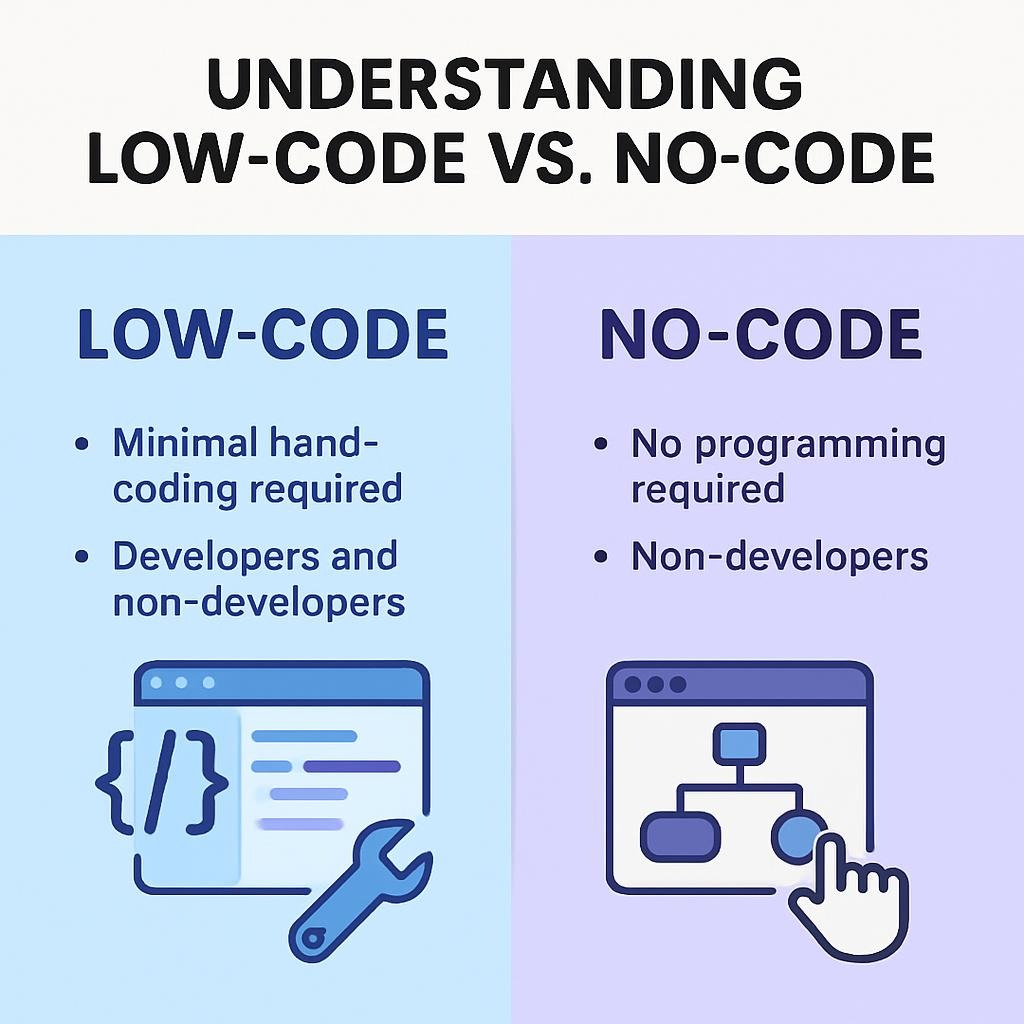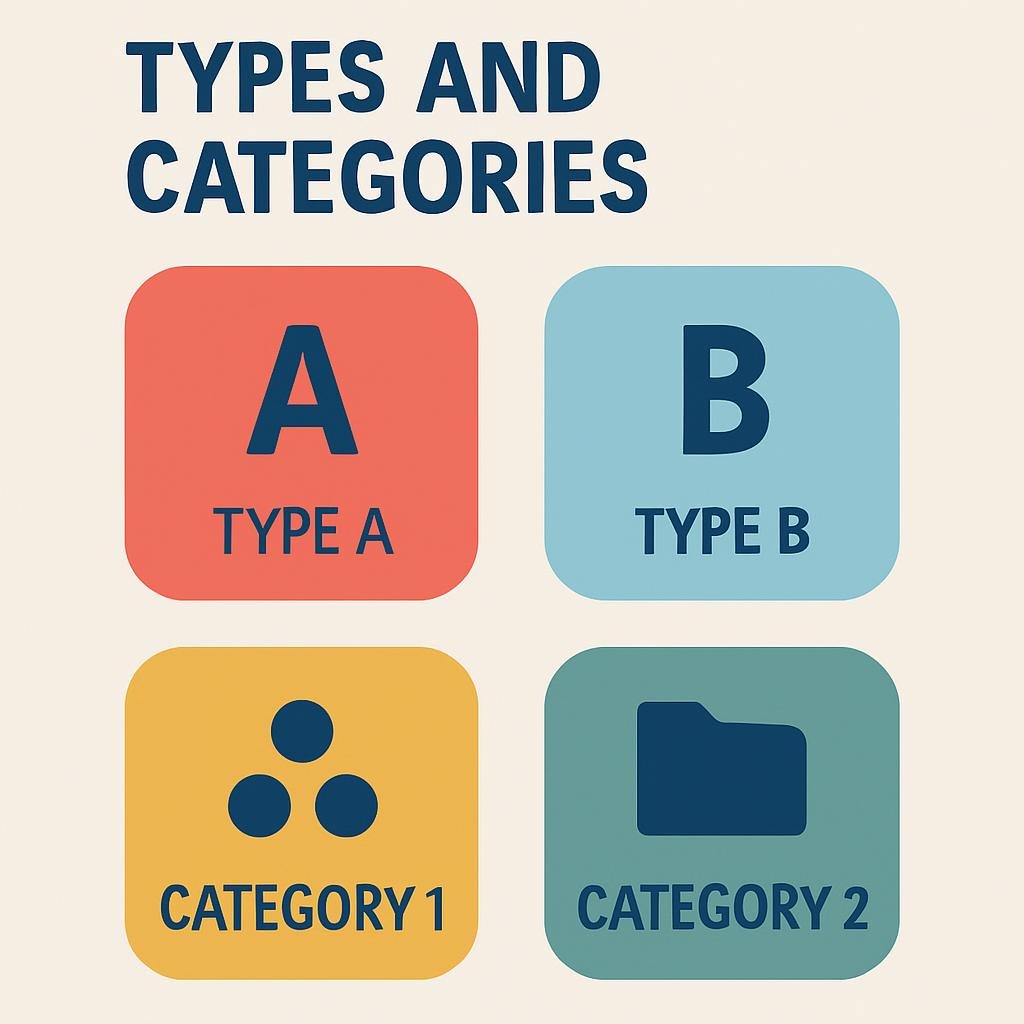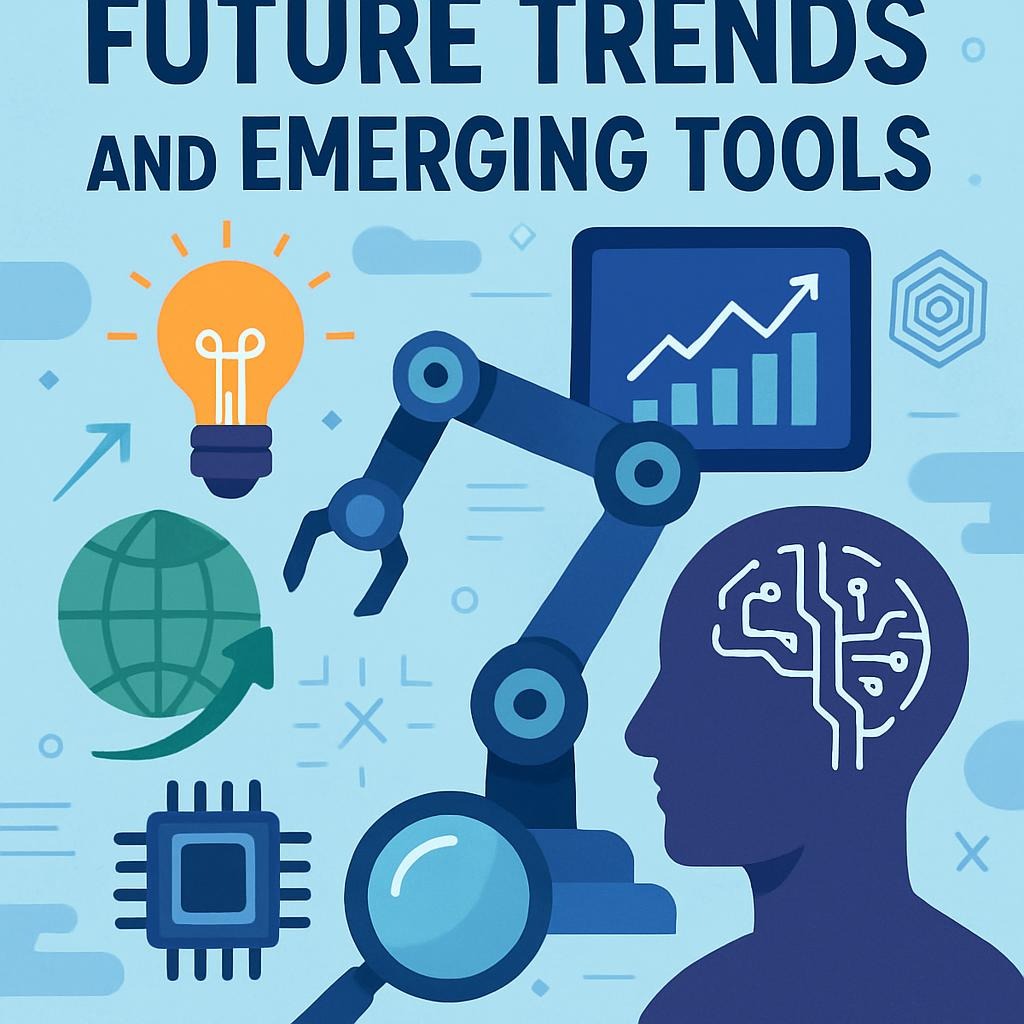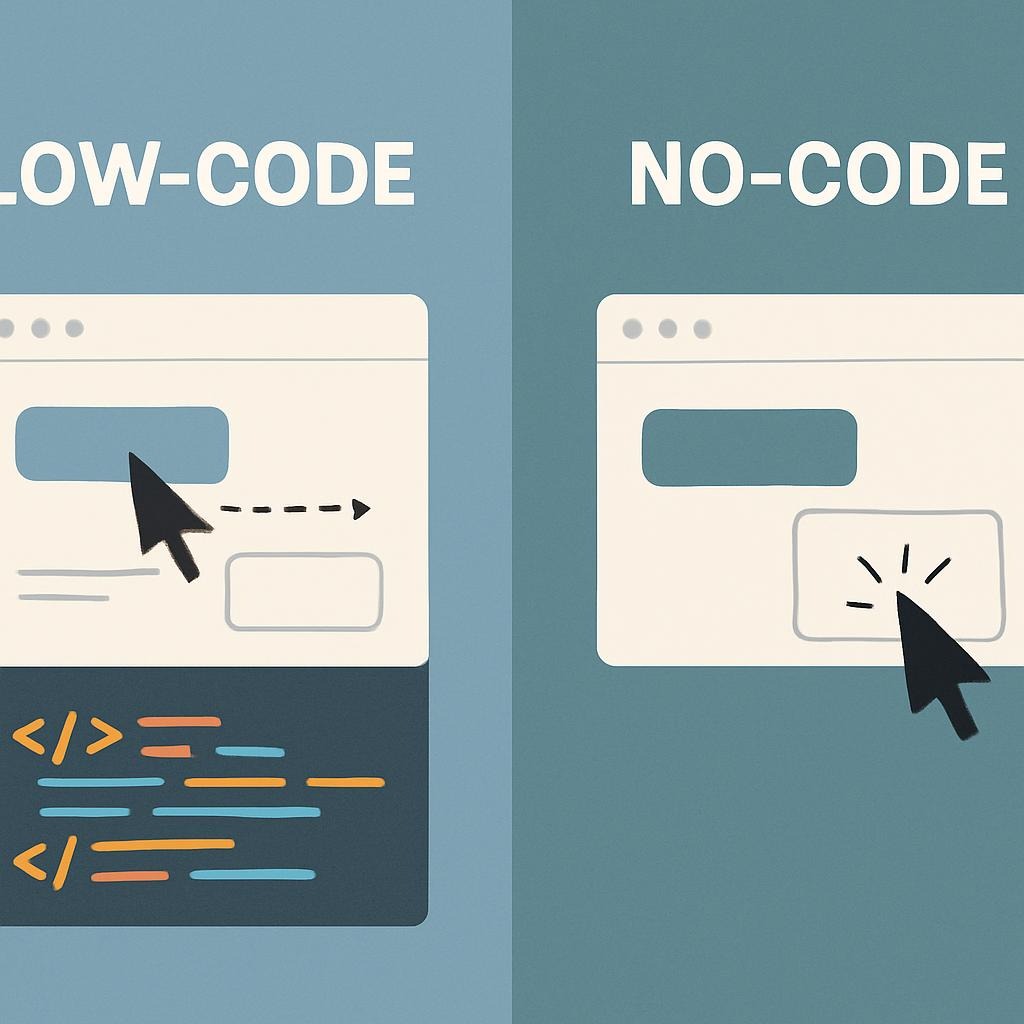Low‑Code vs No‑Code
The digital transformation landscape has undergone a seismic shift in recent years, with low-code and no-code platforms emerging as the great democratizers of software development. What began as simple website builders has evolved into sophisticated development ecosystems that are reshaping how businesses approach application creation in 2025.
The numbers tell a compelling story: by 2025, 50% of all new applications will be created using no-code or low-code technologies, driven by hyperautomation that combines AI, machine learning, and robotic process automation. The global low-code development platform market has exploded from $12.86 billion in 2025 to a projected $264.40 billion by 2032, exhibiting a remarkable CAGR of 32.2%.
This evolution represents more than just a technological trend—it’s a fundamental shift toward citizen development, where business users can create solutions without traditional coding expertise. As we navigate 2025, the choice between low-code and no-code platforms has become increasingly nuanced, with each approach offering distinct advantages for different use cases.
💡 Pro Tip: The rise of AI integration in 2025 has made both low-code and no-code platforms significantly more intelligent, with predictive analytics and automated workflows becoming standard features across leading platforms.
TL;DR: Key Takeaways
- Market Explosion: The low-code/no-code market will reach $187 billion by 2030, with 75% of large enterprises using four or more platforms by 2025
- Speed Advantage: No-code platforms offer 10x faster development for simple applications, while low-code provides 5x speed improvement for complex solutions
- Integration Evolution: Modern platforms now offer seamless API connectivity and pre-built connectors to 500+ popular business applications
- AI Enhancement: 2025 platforms incorporate intelligent automation, reducing manual errors by up to 85%
- Security Maturity: Enterprise-grade security features have become standard, addressing previous governance concerns
- Hybrid Approach: 60% of successful implementations combine both low-code and no-code tools within their development ecosystem
- ROI Impact: Organizations report 300-400% ROI within 12 months of implementation, with significant reductions in IT backlog
Understanding Low-Code vs No-Code: 2025 Definitions

No-Code Development Platforms
No-code development platforms (NCDPs) enable users to create applications through visual interfaces without writing any programming code. These platforms use drag-and-drop functionality, pre-built templates, and graphical user interfaces to allow business users—often called “citizen developers”—to build functional applications.
Key Characteristics:
- Zero coding knowledge required
- Visual, intuitive interface design
- Pre-built templates and components
- Automated deployment processes
- Built-in security and compliance features
Low-Code Development Platforms
Low-code development platforms (LCDPs) provide a middle ground between traditional coding and no-code solutions. They offer visual development tools while still allowing developers to add custom code when needed for complex functionality or specific integrations.
Key Characteristics:
- Minimal coding knowledge required
- A combination of visual tools and code flexibility
- Advanced customization capabilities
- Professional developer-friendly features
- Enterprise-grade scalability options
Market Comparison Table 2025
| Aspect | No-Code | Low-Code | Traditional Development |
|---|
| Development Speed | 10x faster | 5x faster | Baseline |
| Learning Curve | Days to weeks | Weeks to months | Months to years |
| Customization | Limited to platform features | High flexibility | Unlimited |
| Target Users | Business users, entrepreneurs | Developers, IT teams | Professional developers |
| Market Size 2025 | $8.2 billion | $29.1 billion | $500+ billion |
| Deployment Time | Hours to days | Days to weeks | Weeks to months |
| Maintenance | Platform-managed | Shared responsibility | Full responsibility |
Why Low-Code and No-Code Matter in 2025
Business Impact Revolution
The business landscape of 2025 has been fundamentally transformed by the accessibility of application development. Organizations across industries are experiencing unprecedented agility in responding to market demands, with 84% of enterprises turning to low-code solutions to reduce strain on IT resources and increase speed-to-market.
Quantified Efficiency Gains:
- Development Speed: Applications that traditionally took 6-12 months now launch in 2-6 weeks
- Cost Reduction: Up to 70% reduction in development costs compared to traditional methods
- Resource Optimization: IT teams report an 85% reduction in manual errors through automation
- Time-to-Market: 300% faster deployment of business solutions
The Citizen Developer Revolution
Perhaps the most significant impact has been the emergence of citizen developers—business users who create applications without formal programming training. This shift has democratized innovation, allowing domain experts to directly translate their knowledge into functional solutions.
💡 Pro Tip: Successful organizations in 2025 are implementing “Centers of Excellence” that provide governance and best practices for citizen developers while maintaining innovation speed.
Safety and Governance Evolution
Early concerns about security and governance in low-code/no-code platforms have largely been addressed through enterprise-grade features introduced in 2024-2025:
- Advanced Security: Built-in encryption, SSO integration, and compliance frameworks (SOX, HIPAA, GDPR)
- Governance Controls: Automated approval workflows and deployment gates
- Audit Capabilities: Complete application lifecycle tracking and change management
- Data Protection: Automated backup, disaster recovery, and data residency controls
Types and Categories: The 2025 Landscape

No-Code Platform Categories
| Category | Description | Leading Example | Best For | Potential Pitfalls |
|---|---|---|---|---|
| Website Builders | Visual website creation with hosting | Webflow, Wix | Marketing sites, portfolios | Limited backend functionality |
| App Builders | Mobile and web app creation | Bubble, Glide | Customer-facing apps | Performance at scale |
| Workflow Automation | Business process automation | Zapier, Microsoft Power Automate | Operational efficiency | Complex logic limitations |
| Database Apps | Data-driven application builders | Airtable, Notion | Internal tools, CRM | Advanced reporting constraints |
| E-commerce Platforms | Online store creators | Shopify, Square | Retail businesses | Customization boundaries |
Low-Code Platform Categories
| Category | Description | Leading Example | Best For | Technical Notes |
|---|
| Enterprise Platforms | Full-stack application development | OutSystems, Mendix | Large-scale applications | Requires DevOps knowledge |
| Rapid Application Development | Quick business app creation | Microsoft Power Apps, Salesforce Lightning | Departmental solutions | Integration complexity |
| Business Process Management | Workflow and process optimization | Appian, Pega | Process-heavy organizations | Change management needs |
| Integration Platforms | API and system connectivity | MuleSoft, Boomi | System integration projects | Network architecture knowledge |
| Data Analytics | Self-service BI and reporting | Tableau, Power BI | Data-driven insights | Statistical expertise beneficial |
💡 Pro Tip: The most successful implementations in 2025 combine multiple platform types—using no-code for rapid prototyping and low-code for production-ready applications.
Essential Components and Building Blocks
Core No-Code Components
Visual Design Interface Modern no-code platforms feature sophisticated drag-and-drop interfaces with responsive design capabilities, theme customization, and component libraries. These interfaces have evolved to include AI-powered design suggestions and automatic layout optimization.
Pre-Built Templates and Components
- Industry-specific templates (healthcare, finance, retail)
- Reusable UI components and blocks
- Integration-ready modules
- Mobile-responsive elements
Automated Workflows Advanced workflow engines now include:
- Conditional logic builders
- Multi-step approval processes
- Scheduled automation
- Event-triggered actions
- AI-powered decision trees
Advanced Low-Code Building Blocks
Custom Code Integration Low-code platforms provide multiple ways to extend functionality:
- JavaScript/Python code insertion points
- Custom API development
- Database query builders
- Third-party library integration
Advanced Data Management
- Real-time database synchronization
- Advanced query capabilities
- Data transformation tools
- Analytics and reporting engines
Enterprise Integration Capabilities
- RESTful API connectivity
- Enterprise system connectors (SAP, Oracle, Salesforce)
- Identity and access management
- Single sign-on (SSO) integration
2025 Innovation: Adaptive Features
The latest platforms incorporate machine learning to provide:
- Predictive UI: Automatically suggests optimal user interface layouts
- Smart Data Mapping: AI-powered field matching during integrations
- Intelligent Testing: Automated quality assurance and bug detection
- Performance Optimization: Automatic code and database optimization
Advanced Techniques and Strategies for 2025

No-Code Mastery Techniques
Component Library Development: Create reusable component libraries that can be shared across projects and teams. This approach reduces development time by 40-60% for subsequent applications.
Example Workflow:
1. Design core UI components (buttons, forms, cards)
2. Create standardized data models
3. Build template workflows for common processes
4. Establish brand guidelines and style systems
5. Implement version control for componentsAdvanced Automation Strategies
- Multi-Platform Orchestration: Connect multiple no-code tools through APIs
- Data Pipeline Automation: Create sophisticated ETL processes using visual tools
- Conditional Workflow Logic: Implement complex business rules without coding
💡 Pro Tip: Use Zapier’s new “Paths” feature to create sophisticated conditional workflows that rival traditional coded solutions in complexity.
Low-Code Power User Techniques
Hybrid Development Approach The most effective low-code implementations combine visual development with strategic code insertion:
javascript
// Example: Custom validation function in a low-code form
function validateComplexBusinessRule(formData) {
// Custom business logic that would be difficult to create visually
const riskScore = calculateRiskScore(formData.income, formData.creditHistory);
return riskScore < 0.7 ? 'approved' : 'review_required';
}API-First Architecture Design applications with API-first principles:
- Create robust data models with clear relationships
- Expose core functionality through APIs
- Build multiple front-end interfaces for different user types
- Enable seamless integration with external systems
Microservice Integration Break complex applications into smaller, manageable services:
- User authentication service
- Data processing service
- Notification service
- Reporting service
Platform-Specific Advanced Techniques
Microsoft Power Platform Mastery
- Power Apps Canvas Apps: Use formulas and expressions for complex calculations
- Power Automate: Create sophisticated approval workflows with parallel branches
- Power BI: Embed real-time dashboards directly into applications
OutSystems Advanced Patterns
- Architecture Canvas: Design scalable application architectures
- Service Studio: Implement complex business logic with visual programming
- Integration Builder: Create robust API integrations with error handling
Real-World Applications and Success Stories
Case Study 1: Financial Services Transformation
Company: Regional Bank (Assets: $5B)
Challenge: The Manual loan approval process takes 14 days
Solution: Low-code application using Appian BPM
Results:
- Approval time reduced to 24 hours
- 85% reduction in manual errors
- $2.3M annual cost savings
- 400% ROI in first year
Key Success Factors:
- Integration with core banking systems
- Automated document verification
- Real-time risk assessment algorithms
- Mobile-first design for field officers
Case Study 2: Healthcare Digital Transformation
Company: Multi-location Medical Practice
Challenge: Patient data scattered across multiple systems
Solution: No-code solution using Microsoft Power Apps
Results:
- Unified patient portal reducing admin time by 60%
- Improved patient satisfaction scores by 35%
- HIPAA-compliant data management
- $500K saved in IT development costs
Case Study 3: Manufacturing Operations Optimization
Company: Automotive Parts Manufacturer
Challenge: Inefficient quality control and inventory management
Solution: Hybrid low-code/no-code implementation
Results:
- 50% reduction in quality control inspection time
- Real-time inventory tracking across 12 locations
- Predictive maintenance reduces downtime by 30%
- Integration with existing ERP systems
💡 Pro Tip: The most successful implementations start with a pilot project in a single department before scaling organization-wide.
Case Study 4: Retail Customer Experience Enhancement
Company: Mid-size Fashion Retailer
Challenge: Disconnected online and in-store experiences
Solution: No-code e-commerce platform with custom integrations
Results:
- Unified customer experience across channels
- 25% increase in customer lifetime value
- Real-time inventory synchronization
- Mobile app deployed in 6 weeks vs. 6 6-month traditional timeline
Case Study 5: Educational Institution Modernization
Company: Private University (15,000 students)
Challenge: Legacy student information systems
Solution: Low-code platform for student services portal
Results:
- Self-service portal reducing help desk tickets by 70%
- Streamlined enrollment process improving student satisfaction
- Automated transcript and certification processes
- Integration with existing academic systems
Challenges and Security Considerations
Security Challenges in 2025
Despite significant improvements, low-code and no-code platforms still present unique security considerations:
Data Governance Risks
- Shadow IT Growth: Uncontrolled proliferation of applications outside IT oversight
- Data Silos: Information scattered across multiple platform instances
- Compliance Gaps: Potential violations of industry regulations (GDPR, HIPAA, SOX)
Technical Security Concerns
- API Vulnerabilities: Exposed endpoints in third-party integrations
- Access Control: Inadequate user permission management
- Data Residency: Unclear data storage locations in cloud platforms
Best Practices for Secure Implementation
Governance Framework
- Center of Excellence (CoE): Establish a centralized governance team
- Platform Standards: Define approved platforms and usage guidelines
- Security Reviews: Mandatory security assessments for all applications
- Training Programs: Educate citizen developers on security best practices
Technical Safeguards
- Single Sign-On (SSO): Centralized authentication across all platforms
- Data Loss Prevention (DLP): Automated scanning for sensitive information
- Regular Audits: Quarterly security assessments and penetration testing
- Backup Strategies: Automated data backup and disaster recovery plans
💡 Pro Tip: Implement a “Security by Design” approach where security requirements are built into templates and reusable components.
Compliance and Regulatory Considerations
Industry-Specific Requirements
- Healthcare (HIPAA): Patient data protection and audit trails
- Financial Services (SOX): Financial reporting accuracy and controls
- EU Operations (GDPR): Data privacy and right to be forgotten
- Government (FedRAMP): Federal security standards compliance
Mitigation Strategies
- Choose platforms with built-in compliance features
- Implement data classification and handling procedures
- Maintain detailed audit logs and change tracking
- Regular compliance assessments and remediation
Future Trends and Emerging Tools (2025-2026)

AI Integration Revolution
The next wave of low-code/no-code evolution centers around artificial intelligence integration:
Predictive Development
- Smart Templates: AI suggests optimal application structures based on requirements
- Automated Testing: Machine learning identifies potential bugs and performance issues
- Code Generation: Natural language processing converts business requirements into applications
Intelligent Automation
- Process Mining: AI analyzes existing workflows to suggest automation opportunities
- Decision Intelligence: Automated decision-making based on historical data patterns
- Predictive Analytics: Built-in machine learning models for business forecasting
Emerging Platform Categories
Conversational App Builders Platforms that allow users to create applications through natural language conversations:
- Leading Tools: Microsoft Copilot Studio, Google AppSheet with Duet AI
- Use Cases: Rapid prototyping, requirement gathering, application maintenance
Blockchain Integration Platforms: Low-code tools for decentralized application (dApp) development:
- Key Features: Smart contract templates, cryptocurrency payment integration
- Target Market: Financial services, supply chain, digital identity solutions
IoT Application Builders: Specialized platforms for Internet of Things solution development:
- Capabilities: Device management, sensor data processing, real-time analytics
- Growth Driver: Increasing adoption of smart manufacturing and connected devices
Technology Convergence Trends
Edge Computing Integration: Platforms are beginning to support edge deployment for improved performance:
- Reduced latency for real-time applications
- Local data processing for privacy compliance
- Offline-first application capabilities
Quantum Computing Preparation: Forward-thinking platforms are preparing for quantum computing integration:
- Quantum algorithm templates
- Quantum-safe encryption standards
- Hybrid classical-quantum workflows
💡 Pro Tip: Organizations investing in platforms with strong AI roadmaps and integration capabilities will be best positioned for the next wave of innovation.
Market Predictions 2025-2026
Platform Consolidation
- Major cloud providers (AWS, Microsoft, Google) will acquire specialized platforms
- Integration between platforms will become seamless through standard APIs
- Industry-specific platforms will emerge for healthcare, finance, and manufacturing
Citizen Developer Growth
- 500+ million citizen developers globally by 2026
- Professional developer roles will shift toward platform customization and governance
- New job categories: “Low-Code Architects” and “Citizen Developer Coaches”
Enterprise Adoption Acceleration
- 90% of Fortune 500 companies will have formal low-code/no-code strategies
- An average enterprise will use 8-12 different platforms across departments
- Integration platforms will become critical infrastructure components
People Also Ask (PAA) Block
What is the main difference between low-code and no-code platforms?
The primary difference lies in technical flexibility and target users. No-code platforms enable complete application development through visual interfaces without any coding knowledge, making them ideal for business users and citizen developers. Low-code platforms provide visual development tools but allow developers to add custom code for complex functionality, targeting professional developers and IT teams who need more customization options.
Are low-code and no-code platforms suitable for enterprise applications?
Yes, modern low-code and no-code platforms have evolved significantly to support enterprise-grade applications. Leading platforms like OutSystems, Microsoft Power Platform, and Appian offer enterprise security features, compliance frameworks (SOX, HIPAA, GDPR), scalability options, and integration capabilities with existing enterprise systems. However, the choice depends on application complexity, security requirements, and scalability needs.
How much can businesses save by using low-code/no-code platforms?
Organizations typically see a 60-80% reduction in development costs and a 300-400% ROI within 12 months. Cost savings come from faster development (10x for no-code, 5x for low-code), reduced need for specialized developers, lower maintenance requirements, and faster time-to-market. However, savings vary based on application complexity, platform choice, and implementation strategy.
What are the security risks of low-code and no-code development?
Main security concerns include shadow IT proliferation, data governance challenges, API vulnerabilities, and potential compliance violations. However, enterprise platforms now offer robust security features, including SSO integration, encryption, audit trails, and compliance frameworks. Risk mitigation requires proper governance, security training for citizen developers, and regular security assessments.
Which industries benefit most from low-code/no-code platforms?
Financial services, healthcare, manufacturing, retail, and education see the highest adoption rates. These industries benefit from rapid digitization needs, regulatory compliance requirements, and the ability to quickly adapt to market changes. Any industry with significant manual processes, data integration needs, or customer experience requirements can benefit from these platforms.
Can low-code/no-code replace traditional software development?
While these platforms handle many use cases effectively, they complement rather than replace traditional development. Complex applications requiring custom algorithms, high-performance computing, or unique technical requirements still need traditional coding. The trend is toward hybrid approaches where organizations use the right tool for each specific need, with 75% of enterprises expected to use multiple platforms by 2025.
Frequently Asked Questions

Q: How do I choose between low-code and no-code for my project?
A: Consider these factors:
- User Expertise: Choose no-code if your team lacks technical skills, low-code if you have developers available
- Complexity Requirements: No-code for simple to moderate complexity, low-code for advanced functionality needs
- Integration Needs: Low-code offers better integration capabilities for complex enterprise systems
- Timeline: No-code provides faster initial deployment, and low-code offers better long-term scalability
- Budget: No-code typically has lower upfront costs, but low-code may be more cost-effective for complex applications
Q: What happens if I outgrow my chosen platform?
A: Modern platforms offer migration paths and data export capabilities. Start with clearly defined exit strategies:
- Ensure data portability through standard formats (JSON, XML, CSV)
- Choose platforms with strong API capabilities for integration flexibility
- Consider hybrid approaches that allow gradual migration
- Plan for potential re-platforming costs in your long-term strategy
Q: How do I ensure governance and security in citizen development?
A: Implement a Center of Excellence (CoE) framework:
- Establish approved platform lists and usage guidelines
- Provide security training for citizen developers
- Implement automated security scanning and compliance checks
- Regular audits and application lifecycle management
- Clear data classification and handling procedures
Q: What skills should I develop to be successful with these platforms?
A: For No-Code success:
- Process mapping and workflow design
- Basic database concepts and data modeling
- User experience (UX) design principles
- Business analysis and requirements gathering
For Low-Code success:
- Fundamental programming concepts
- API integration and web services
- Database design and query optimization
- Software architecture principles
Q: How do licensing costs compare between platforms?
A: Pricing models vary significantly:
- Per-User Models: $10-100+ per user per month
- Application-Based: $100-1000+ per application per month
- Usage-Based: Based on transactions, data storage, or API calls
- Enterprise Licenses: Custom pricing for unlimited users/applications
Consider the total cost of ownership, including development time, maintenance, and scaling requirements.
Q: Can I integrate low-code/no-code applications with existing systems?
A: Yes, modern platforms offer extensive integration capabilities:
- Pre-built connectors for popular business applications (Salesforce, SAP, Oracle)
- RESTful API support for custom integrations
- Database connectivity options (SQL Server, Oracle, MySQL, PostgreSQL)
- File-based integrations (CSV, XML, JSON)
- Real-time and batch processing options
Conclusion
The low-code vs no-code decision in 2025 isn’t simply about choosing one approach over another—it’s about understanding which tool fits your specific needs and how these platforms can work together to accelerate your digital transformation journey.
The evidence is clear: organizations embracing these platforms are seeing unprecedented returns on investment, with 300-400% ROI within the first year and dramatic improvements in development speed and business agility. The market’s explosive growth from $12.86 billion to a projected $264.40 billion by 2032 reflects not just a trend but a fundamental shift in how we approach software development.
Key Decision Framework:
- Start with No-Code: if you’re a business user looking to solve immediate problems, need rapid prototyping capabilities, or want to test concepts quickly
- Choose Low-Code: if you’re building complex enterprise applications, need extensive customization, or have developers who can leverage coding capabilities
- Consider Hybrid Approaches: for comprehensive digital transformation initiatives that require both rapid deployment and sophisticated functionality
The most successful organizations in 2025 are those that view low-code and no-code as complementary tools in their development toolkit rather than competing alternatives. They’re building Centers of Excellence, investing in citizen developer training, and creating governance frameworks that enable innovation while maintaining security and compliance.
As we look toward 2026 and beyond, the integration of AI, the emergence of conversational development, and the continued democratization of technology creation will only accelerate these trends. The question isn’t whether your organization should adopt these platforms, but how quickly you can implement them effectively.
Ready to get started? Begin with a pilot project in a single department, choose a platform that aligns with your team’s technical capabilities, and focus on delivering immediate business value. The future of application development is here, and it’s more accessible than ever before.
Take Action Today
- Assess Your Needs: Use the decision framework provided to evaluate your specific requirements
- Start Small: Choose a pilot project with clear success metrics and a manageable scope
- Invest in Training: Develop your team’s skills through platform-specific training programs
- Plan for Scale: Design governance frameworks that will support organization-wide adoption
- Stay Informed: Follow platform roadmaps and emerging trends to maximize your investment
The democratization of software development is not just changing how we build applications—it’s transforming how we think about innovation, collaboration, and digital capability. Whether you choose low-code, no-code, or a combination of both, the key is to start your journey now and iterate as you learn.
References:
- Hostinger – “26 No-code and low-code trends for 2025”
- UserGuiding – “120+ No-Code/Low-Code Statistics and Trends That You Need to Know in 2025”
- Fortune Business Insights – “Low Code Development Platform Market Size, Share [2032]”
- Precedence Research – “Low-Code Development Platform Market Size to Hit USD 82.37 Bn by 2034”
- Kissflow – “35 Must-Know Low-Code Statistics and Facts for 2025!”
- Quixy – “Top 10 No-Code Low-Code Trends for 2025: Breaking Barriers”
- Microsoft Power Apps – “Low-Code vs. No-Code App Development”
- Salesforce – “Low-Code vs. No-Code: Key Similarities & Differences”
- SAP – “Low-Code/No-Code: The Future of Development”
- Zapier – “The 8 best no-code app builders in 2025”
External Resources:
- Gartner Low-Code Application Platforms Magic Quadrant
- Forrester Wave: Low-Code Development Platforms
- OutSystems State of Application Development Report
- Microsoft Power Platform Learning Path
- No-Code/Low-Code Industry Association
- Low-Code Research and Development Resources
- Citizen Development Best Practices Guide
- Enterprise Low-Code Security Framework
